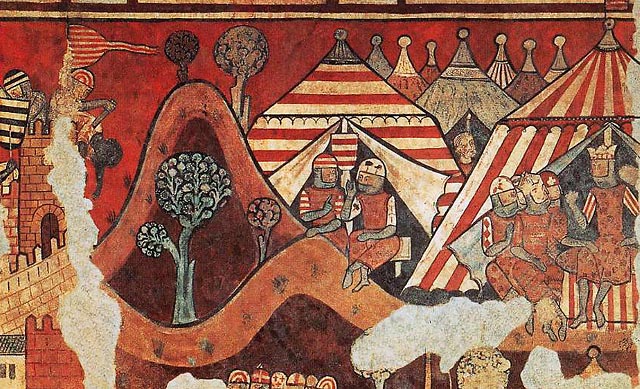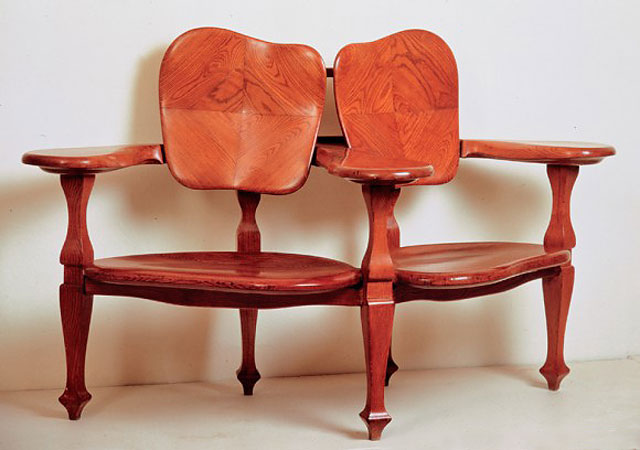Hello! I’m Catherine, one of the guides at Runner Bean Tours in Barcelona. With a background in History of Art and Museum Studies, I often get asked for museum recommendations when leading tours. With over 50 to suggest, from chocolate to archaeology to shoes, Barcelona has a museum to suit any interest! But when asked for my own personal choice, I can’t help advise a trip to the MNAC (Museu Nacional d’Art de Catalunya), for several reasons.
Situated in Montjüic, the museum overlooks some of the most stunning views of the city. The building itself is an architectural treat (a huge Italian-style palace built for the 1929 International Exhibition) and the collection, boasting over 1,000 years of art, is a must for those interested in Catalonia’s Art history. But with such a huge amount of artwork on display, the museum can be overwhelming. So what I’d like to do is talk through my favourite pieces some of which you should be able to place historically after taking my tours.
The Romanesque collection
The Romanesque collection is the most important of its kind in the entire world. This is due to a huge effort made in the 19th and 20th centuries to preserve and promote Art located in the Romanesque churches of the region. Today, these pieces are found in the museum in the form of colourful frescoes, detailed wood panels, and intricate stone carvings. Most of the works date from the 11th and 12th centuries, reflecting the techniques and expertise of artists during the early history of Catalonia.
“Apse of Sant Climent de Taull” by the Master of Taull (c. 1123)

This is one of the most outstanding examples of the exhibit. Considered the greatest mural painter in the 12th century and one of the most important Romanesque painters in Europe, this mural by the Master of Taull was originally located in the Church of Sant Climent de Taull at the Vall de Boí in the Catalan Pyrenees. Removed and transported to Barcelona between 1919 and 1923, the fresco is admired for its pictorial strength and use of colour and has inspired reknowned artists such as Picasso and Francis Picabia. The painting has been transferred onto a replica of its original apse, giving you a great sense of how it appeared centuries ago in its original location.
The Gothic collection
Artwork from the 13th to the 15th centuries can be discovered in the Gothic section. As we discover on our Gothic Quarter free walking tour, this was a peak time in Catalan history. The union with the Crown of Aragon and the conquest of a great part of the Mediterranean, results in a body of work, not only from Catalonia, but other territories that were once part of the Crown of Aragon, such as Valencia and Majorca.
The mural paintings of the Conquest of Majorca (1285-1290)

Not to be missed! These mural paintings were discovered in 1961 during the restoration of Palau Aguilar, part of a palace which today makes up the city’s Picasso Museum. They are one of the most important examples of Catalan linear gothic painting and show the conquest of Majorca by King James I, “the conqueror”, in 1229 (watch out for the statue of the king on the façade of the City Hall during our Old City tour). Although the paintings are damaged, the sequence of the conquest can be read from left to right, divided between three panels, showing the glory of the Catalan army and the downfall of the Moors in battle.
The Modern Art collection
Another fantastic part of the MNAC is the Modern Art section. The artwork dates from the 19th and 20th centuries and, once again, reflects a great period in the history of Catalonia. The dawn of the industrial revolution sparked a creative revolution, and those of you who have joined us on the Gaudí free tour will really enjoy this part of the museum. The Modernisme collection gives you a wonderful insight into what his contemporaries were creating at the time.
“Llar de foc” by Lluis Domènech i Montaner (1907)

This chimney place from the modernist architect of Casa Lleó Morera (one of the houses on the Block of Discord) gives you a sense of the luxury that the nouveau riche enjoyed behind closed doors in 19th century Barcelona.
“The Cathedral of the Poor” by Joaquim Mir (1898)

A beautiful work, painted in plein air, shows a scene representing the working class of a local neighbourhood. The Sagrada Familia, in its very early stages, provides the background in the work. A way to contrast how far the church has come along from what we visit today!
Double sofa designed for Casa Batlló by Antoni Gaudí (1904-1906)

And of course, not to forget Gaudí! This is an example of the architect’s ability in interior design. The sofa, like Casa Batlló itself, strays from the use of straight lines and right angles. The result is corner-less furniture that combines comfort with great design.
Practical information
The entrance to the MNAC allows you two visits to the museum as, with such a vast collection, recommended visiting time can be up to and beyond 3 hours. I wouldn’t say there is an ideal time to see the works. However, if you manage to schedule your visit to a Saturday evening, you’re in luck! The museum is free after 3pm on Saturdays and it tends to be a more livelier time to check out the collection. And to top it off, the Magic Fountain begins at twilight giving you enough time to grab a refreshment on the terrace and watch the sun set over the city while waiting for the show to commence. A perfect way to round up your experience at the MNAC. Enjoy your visit!
Opening Times:
- Closed Mondays
- Tuesdays to Saturdays: 10am to 6pm (until 8pm during Summer months)
- Sundays and public holidays: 10am to 3pm
Prices:
- Adults € 12 (valid for two days)
- Concessions get 30% discount
- Free for children under 16
- Admission is also free every Saturday after 3pm and the first Sunday of every month.
How to get there:
From Plaça Espanya head down Avinguda Maria Cristina and you will see the museum straight away. Continue up via the escalators or, if you’re feeling particularly fit, take the stairs.
- Metro: L1, L3 (Plaça Espanya)
- Bus: 150, 13, 55
- FGC: L8, S33, S4, S8, R5, R50, R6, R60
Photographs by Dena Flows and MNAC collection











We will be in Barcelona on April 22-24th 2019
We have been there before.
are there any events during this time?
Sant Jordi’s Day is on the 23rd and it is a lovely day to be in Barcelona. You can keep an eye on our post of what to do in Barcelona in April to see what events will be happening next year. The post is for the 2018 events but we will update it in 2019.